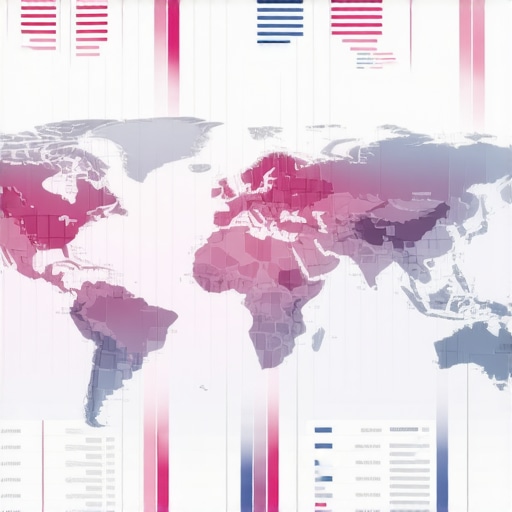My First Encounter with Maps Analytics & Local SEO Reports
Last year, I found myself lost in the maze of local SEO metrics, trying to decipher what truly mattered for my business. It was a pivotal moment when I realized that understanding Maps Analytics & Local SEO Reports isn’t just about numbers; it’s about unlocking real growth. Diving into tools like Google My Business performance reports and local keyword dashboards, I started to see patterns that transformed my approach.
Why I Believe Maps Analytics Are Your Secret Weapon in 2025
In my experience, effective maps analytics provide the insights needed to refine your local SEO strategies. For example, tracking user engagement on Google Maps helped me identify the most active hours and days. This data allowed me to optimize my business hours and improve visibility during peak times. I learned that a comprehensive Maps Analytics report can elevate your local presence significantly.
How to Craft Your Own Local SEO Report for 2025
Creating a local SEO report isn’t just about collecting data; it’s about telling a story. I started by focusing on key performance indicators (KPIs) such as local rankings, review scores, and click-through rates. Using tools like rank trackers, I could monitor my progress over time and adjust my tactics accordingly. The goal? To make data-driven decisions that boost my local visibility and conversions.
What If I Still Don’t Fully Understand These Reports?
Ever Wondered How to Truly Interpret Your Maps Data for Better Results?
If you’re like me, sometimes the data can seem overwhelming. But breaking it down into manageable parts — like focusing on local search impressions or customer actions — made it simpler. I recommend consulting authoritative sources like SEO KPI dashboards that help translate raw data into actionable insights. Don’t hesitate to experiment and see what metrics resonate most with your goals.
I’d love to hear your experiences with local SEO reports. Feel free to share your tips or ask questions in the comments below!
Unlocking the Power of Local Search Data: A Deep Dive
As local SEO continues to evolve, understanding the nuances of Maps Analytics becomes crucial for sustained growth. One often overlooked aspect is analyzing customer journey touchpoints within local maps and directories. By examining how users interact with your business listing—such as clicking on directions, viewing photos, or reading reviews—you can tailor your optimization efforts more precisely. Leveraging insights from authoritative sources like effective Maps Analytics strategies enables you to identify which elements most influence customer conversions.
Integrating Local KPIs for Holistic SEO Performance
Beyond basic metrics, integrating local SEO KPIs—such as proximity ranking, review sentiment, and engagement rates—provides a comprehensive view of your performance. For instance, tracking how your Google My Business (GMB) insights align with your website analytics reveals gaps and opportunities. Consider the importance of consistent NAP (Name, Address, Phone Number) data across all platforms; discrepancies can harm your local rankings. To streamline this process, many experts recommend utilizing advanced dashboard tools like SEO KPI dashboards that consolidate data from multiple sources, providing actionable insights at a glance.
How Can Advanced Analytics Transform Your Local SEO Strategy?
By harnessing sophisticated analytics, local businesses can predict customer behavior trends, optimize their Google My Business posts, and refine their local content strategies. For example, analyzing seasonal fluctuations in map searches can inform your marketing calendar, ensuring you capitalize on peak interest periods. Moreover, integrating Maps Analytics with voice search data can reveal new opportunities to capture voice-activated local queries, a rapidly growing segment. Stay ahead by exploring resources like best GMB performance trackers for 2025.

What Are the Practical Challenges in Interpreting Local Search Data?
One common challenge is distinguishing between correlation and causation in your metrics. For example, a spike in directions requests might coincide with a local event but not necessarily result from your recent optimization efforts. To avoid misleading conclusions, it’s vital to contextualize data and cross-reference multiple metrics. Additionally, privacy considerations and data accuracy can impact your analysis. Consulting trusted sources like top local SEO dashboards can help you navigate these challenges effectively.
Curious about how other local businesses are leveraging analytics for competitive advantage? Share your insights or ask for tips in the comments below, and don’t forget to explore more about unlocking your local SEO potential with our comprehensive reports.
Beyond the Basics: Mastering the Intricacies of Local Search Data
As I delved deeper into the world of Maps Analytics, I realized that the real challenge lies not just in collecting data but in interpreting its subtle nuances. For instance, understanding the difference between a genuine increase in customer actions versus a seasonal fluctuation can be perplexing. I remember a period when my directions requests skyrocketed, but it was tied to a local festival rather than any specific SEO effort I made. Distinguishing such correlations requires a keen eye and a comprehensive understanding of external factors, which I learned through persistent analysis and cross-referencing multiple data points.
How Can I Refine My Data Interpretation Skills to Outperform Competitors?
This question has haunted many local SEO practitioners, including myself, especially when faced with conflicting metrics. One approach I found invaluable is leveraging advanced tools like ranking trackers that offer granular insights and trend analyses. These tools help me identify not just what is happening but why it is happening, enabling strategic adjustments. For example, noticing a decline in review sentiment prompted me to enhance my customer service, which eventually improved my overall rankings. The key is to view data as a storytelling device—each metric a chapter revealing your ongoing narrative of local SEO evolution.
Personal Reflections: Embracing Complexity in Local SEO
One thing I’ve come to appreciate deeply is that local SEO is a complex puzzle. There’s no one-size-fits-all solution, and the beauty lies in deciphering how different pieces—like Google My Business insights, customer reviews, and map interactions—interconnect. This complexity can be intimidating, but it also offers endless opportunities for creative problem-solving. I often spend hours analyzing effective strategies for maps analytics, experimenting with new tactics, and observing what resonates with my local audience. This iterative process has been crucial in staying ahead of competitors and continuously refining my approach.
What Role Does Privacy Play in Data Analysis and How Do I Navigate It?
Privacy concerns are an increasingly prominent aspect of local SEO analytics. Balancing the need for detailed insights with respect for user privacy is delicate. I’ve learned to prioritize aggregated data over individual user data, ensuring compliance with policies like the privacy policy. This not only keeps my practices ethical but also builds trust with my audience. Moreover, exploring anonymized data sources can provide valuable trends without infringing on privacy, a lesson I wish I had adopted sooner. The challenge remains to extract meaningful insights while respecting user confidentiality—an ongoing learning curve that demands vigilance and adaptability.
As I continue to navigate the evolving landscape of local search analytics, I invite you to reflect on your own experiences. How have you tackled the complexities of data interpretation? Share your insights or ask questions in the comments—I believe that collective wisdom can accelerate our mastery of these powerful tools. For those looking to deepen their understanding, exploring resources like critical report strategies for 2025 could be a game-changer. Remember, the journey to mastering Maps Analytics is ongoing, and every insight gained brings you closer to local SEO excellence.
Deciphering the Hidden Layers of Local Search Data for Strategic Edge
While understanding basic metrics is a solid foundation, truly mastering Maps Analytics involves peeling back layers of data complexity to uncover nuanced insights. For instance, I’ve observed that customer engagement patterns often fluctuate not just due to external events but also because of subtle algorithmic shifts within Google’s local ranking signals. Recognizing these shifts requires a sophisticated analysis approach—tracking long-term trends and correlating them with algorithm updates, such as those detailed in Moz’s comprehensive update analysis. This enables me to adapt my strategies proactively rather than reactively, maintaining a competitive edge.
How Do I Elevate My Data Interpretation Skills to Outperform Competitors?
To surpass others in local SEO, I focus on developing an intuitive understanding of what data truly signifies. This involves cross-referencing ranking tracker insights with qualitative feedback from reviews and customer interactions. For example, a decline in map clicks paired with negative review sentiment alerted me to underlying customer service issues, prompting targeted improvements. Cultivating this holistic view helps me identify not just superficial metric changes but the underlying causes—transforming raw data into actionable growth strategies.
What Advanced Techniques Can Sharpen My Local SEO Data Analysis?
One technique I’ve adopted is leveraging machine learning-powered predictive analytics, which can forecast seasonal surges or declines in local search interest. Incorporating tools like advanced GMB performance reports enables me to anticipate customer behavior shifts and adjust campaigns accordingly. Additionally, integrating voice search analytics has uncovered emerging opportunities for capturing voice-activated local queries—an area many overlook but is rapidly growing, as outlined in recent industry reports. These techniques demand a sophisticated analytical mindset, but they pay dividends in staying ahead of competitors.

Balancing Privacy and Precision in Data-Driven Local SEO
Privacy considerations are paramount as I delve into granular analytics. I’ve shifted toward aggregated data insights, ensuring compliance with policies like privacy regulations while still extracting meaningful trends. For example, anonymized heatmaps of customer directions requests help me identify high-interest zones without infringing on individual privacy. This ethical approach not only safeguards user trust but also enhances my long-term data accuracy, as privacy-sensitive data tends to be more reliable over time. Navigating this delicate balance requires ongoing vigilance and adherence to evolving legal standards.
In What Ways Can Deep Data Analysis Drive Innovation in Local SEO?
Innovative local SEO strategies stem from the ability to interpret data creatively. For instance, analyzing the timing of customer interactions across multiple channels revealed a pattern—customers preferred engaging with Google My Business during lunch hours, prompting me to schedule posts and promotions during those times. Such insights, drawn from comprehensive KPI dashboards, fuel my experimentation with new content formats and engagement tactics. Embracing these data-driven innovations ensures my local SEO efforts remain dynamic, responsive, and ahead of industry trends.
Things I Wish I Knew Earlier (or You Might Find Surprising)
The Hidden Power of Data Nuance
Early in my journey, I underestimated how crucial understanding the subtle nuances in Maps Analytics could be. For example, recognizing seasonal patterns versus algorithmic shifts helped me refine my strategies more effectively. It’s like listening to a complex piece of music—every note matters and can tell a different story if you pay attention.
The Myth of Instant Results
I once thought that tweaking my local listings would yield overnight success. Instead, I learned that consistent analysis and patience—interpreting long-term data trends—are key. It’s a marathon, not a sprint, and data helps you stay the course.
Privacy Is Not a Barrier but a Guide
Initially, I feared privacy restrictions would limit my insights. Turns out, focusing on aggregated and anonymized data not only keeps you compliant but also enhances your understanding of overall trends without infringing on user trust. It’s a win-win.
Cross-Referencing Metrics Is Essential
Relying on one metric can be misleading. I’ve found that correlating map interactions with customer reviews and website analytics paints a much clearer picture of what truly influences your local visibility and conversions.
The Real Value Lies in Storytelling
Data is just numbers until you tell a story. I’ve learned to craft narratives around my Maps Analytics, turning raw data into actionable insights that drive my local SEO tactics forward. It makes the process more engaging and effective.
Resources I’ve Come to Trust Over Time
- Google’s Official My Business Help Center: A reliable source for understanding platform-specific metrics and updates, which I recommend to any local business owner seeking clarity.
- Moz’s Blog on Local SEO: Their in-depth analysis of algorithm changes and ranking factors has helped me stay ahead of industry shifts.
- Search Engine Land: A go-to for industry news, especially their reports on voice search and emerging trends that complement Maps Analytics insights.
- Local SEO Guides by SEMrush: Practical strategies and case studies that have enriched my approach to local SEO analysis and implementation.
Parting Thoughts from My Perspective
Mastering Maps Analytics and Local SEO Reports has transformed the way I approach my business growth in 2025. It’s not just about collecting data but understanding what it reveals about your audience and your market. I encourage you to dive deep, experiment, and let your data tell its story—because that’s where true local SEO success begins. If this resonated with you, I’d love to hear your thoughts. Feel free to share your experiences or ask questions in the comments below. Remember, the journey to local SEO mastery is ongoing, and every insight brings you closer to your goals.



Reading through this insightful post, I can relate to the challenges of interpreting Maps Analytics data at first. It’s easy to get overwhelmed by raw numbers, but focusing on key touchpoints like directions and reviews has really helped me craft better local strategies. The emphasis on storytelling with data resonates strongly—I’ve found that understanding the narrative behind the metrics gives much clearer direction. One thing I’ve started exploring recently is the integration of voice search data, which is proving to be a game-changer for capturing new customer queries. Have others here experimented with voice analytics within their local SEO efforts? I’d be very interested in hearing how it’s impacted your strategies or what tools you’ve used to analyze voice interactions effectively.
This post really resonated with me, especially the point about interpreting subtle nuances in Maps Analytics. Over the past year, I’ve learned that tracking seasonal fluctuations alongside algorithm updates has made a huge difference in refining my local SEO strategies. I used to rely heavily on direct metrics like clicks but realized that layering these with external factors provides a more accurate picture. Recently, I’ve been experimenting with integrating voice search analytics, and the insights are promising. It’s fascinating to see how voice-activated local queries are growing, and optimizing for voice has become a part of my strategy.
One challenge I face now is balancing detailed analytics with user privacy. While I want comprehensive data, I also need to ensure compliance with privacy standards. How do others here approach data privacy without losing the depth of insights needed for effective decision-making? Also, what tools or dashboards have you found most helpful for combining different types of data to get actionable takeaways? Would love to hear your thoughts or experiences on navigating these complexities.